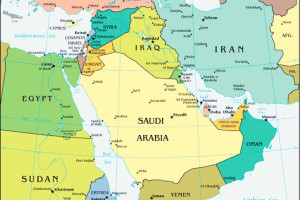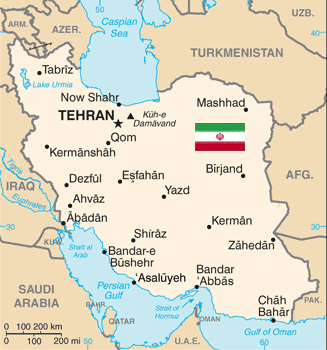Why Russia Ended its Ban on Selling Advanced Air Defense Systems to Iran

(Moscow Times – themoscowtimes.com – Matthew Bodner – April 15, 2015)
Russia’s decision this week to lift a self-imposed embargo on selling powerful S-300 anti-aircraft systems to Iran is likely an attempt to turn the Middle Eastern country into a major new market for Russian arms exports.
 As the international community edges closer to a nuclear deal with Iran, the prospect of lifting international sanctions on the Islamic republic presents weapons manufacturers with windfall opportunities for arms sales.
As the international community edges closer to a nuclear deal with Iran, the prospect of lifting international sanctions on the Islamic republic presents weapons manufacturers with windfall opportunities for arms sales.
“Iran needs to almost entirely re-equip its military. It will need to spend about $40 billion to modernize,” Ben Moores, a senior analyst at arms industry analytics firm IHS, told The Moscow Times on Tuesday.
Moscow wants to grab that market, but it still has barriers to overcome.
Obstacles to Iranian Market
The lifting of the UN embargo on the supply of offensive arms to Iran depends on whether a tentative framework agreement on a nuclear deal reached on April 2 turns into a successful deal in final negotiations in June.
If agreement is reached, Russia’s biggest obstacle to entering the Iranian market will be political resistance, both from Israel, which has highlighted the dangers of arming Iran, and from Iran itself.
Moscow was once Tehran’s largest single supplier of arms, but pulled out of the relationship in favor of closer relations with the West following the end of the Cold War. This, combined with Russia’s 2010 decision to halt the export of the S-300 air defense systems, left Iran embittered.
Iran submitted a $4 billion lawsuit against Russia in the International Court of Arbitration in Geneva – which Tehran has said it would drop if the weapons are delivered.
“Certainly Russia lost credibility when it canceled the S-300 deal,” said Siemon Wezeman, an arms trade expert at the Stockholm International Peace Research Institute (SIPRI), which tracks arms deals.
“But Iran does not have that many options and Russia has in general been publicly fairly supportive of Iran,” Wezeman added, which should play well with Iranian officials in future arms trade negotiations.
However, Russia would have to overcome Israeli opposition to the S-300 and other sales, which Moscow may not be keen to do.
“The Israelis almost tacitly supported Putin in Ukraine and he won’t sacrifice [the relationship] for a handful of dollars,” said Ruslan Pukhov, director of the Center for the Analysis of Strategies and Technologies (CAST), a Moscow-based defense industry think tank.
“As long as [Israeli prime minister Benjamin] Netanyahu is in power … Russia will not be delivering S-300s to Iran,” Pukhov said.
Desperate for Cash
Russia is the world’s second-largest arms exporter, raking in $13 billion last year, according to Russia’s arms export agency, Rosoboronexport. But its arms exports are expected to plateau this year according to IHS.
Some of Russia’s biggest customers, such as Venezuela – which last year received $1 billion worth of Russian arms – are heavily dependent on oil revenues. But the price oil has fallen by half since last summer, and these countries’ budgets are now under pressure. Meanwhile, India and Vietnam, two other major Russian customers, are increasingly buying U.S. arms.
Russia has also been hit by the oil price fall and needs to find new markets to tap and offset these trends. Oil-exporting Iran also suffers from low crude prices, but its need for new hardware would likely still make it a major arms market.
Russia’s Competitive Edge
Russia’s hold over the Iranian arms market is not guaranteed even if it pleases Tehran by delivering the S-300s, the nuclear deal with Iran is successful and UN sanctions are lifted.
Moscow will face stiff competition from suppliers such as China, which “can offer very similar products and has also shown political support for Iran in the past,” said Wezeman.
While some European nations such as Italy may move in to supply Iran, analysts said that the United States and its closest Western allies will shy away from arms deals with Iran, even if a deal is reached.
“But in certain cases Russia can offer things that others won’t,” such as air defenses and airplanes, Pukhov said.
Iran desperately needs airplanes. Its interceptor aircraft are old MiG-29s from the 1970s, and the rest of the air force isn’t much newer.
Pukhov estimated they would be looking to procure at least 24 new aircraft – a contract that could cost up to $3 billion, depending on the specs and armaments included in the deal.
Iran will be looking for more than airplanes. According to Moores, “the priorities [for Iran] will be helicopters, frigates, fighter aircraft, army [communications] and radios, and air defenses.”
Russia is competitive in many of these categories. According to IHS data, Russia last year sold helicopters and aircraft worth around $6.6 billion. It also exported $900 million in ship hulls.
Iran will want this equipment to ward off attacks from their Gulf rivals, according to Pukhov.
Iran’s biggest regional competitor, Saudi Arabia, overtook India last year as the world’s largest arms importer. According to IHS data, the Saudis purchased over $6.4 billion of hardware, mainly from the United States. The United Arab Emirates, another enemy of Tehran’s, was the fourth-largest importer in 2014, spending $2.2 billion on arms.
Meanwhile Iran, said Moores, is using U.S equipment dating from the 1970s.
